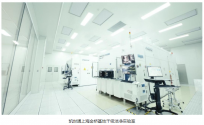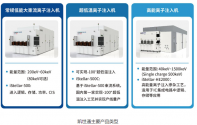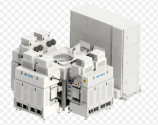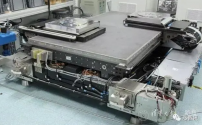ASML is working REALLY HARD lobbying the both the Dutch and Chinese government, to be allowed to service and sell tools in China and to convince the Chinese fabs and the government that they are still a reliable semiconductor supplier.
You are using an out of date browser. It may not display this or other websites correctly.
You should upgrade or use an alternative browser.
You should upgrade or use an alternative browser.
Chinese semiconductor thread II
- Thread starter vincent
- Start date
Who knows, China semiconductor industry is becoming a black box, some of the things I post is because these companies are publicly traded companies (NAURA,pmish-tech, AMEC...) or are looking for investments, so they have to publish their advances in order to entice investors.Or maybe they will announce it on OCT 1 the 75th anniversary of PROC.
Wanye Enterprise 24th Half-Year Report: Multiple New 12-inch Integrated Circuit Customers Repeat Orders
Wanye Enterprise disclosed its 2024 semi-annual report. During the reporting period, the company achieved operating income of 201 million yuan and R&D investment of 76 million yuan, an increase of 41.24% over the same period last year. At this stage, the company is in the transition period of new and old kinetic energy in the industry. Since 2024, the company's real estate sector has entered the final stage, and the reduction in real estate delivery income during the same period has an impact on net profit. At the same time, the company's integrated circuit business continues to break through. From 2024 to date, it has received equipment orders of approximately 220 million yuan. Its subsidiary Kaishitong has added 5 customer orders, of which 3 are repeat orders from mainstream domestic customers and 2 are new customer orders. It is currently the leading supplier of 12-inch low-energy, large-beam ion implanters in China in terms of product delivery volume and process coverage.
During the reporting period, the company increased its R&D investment, with a year-on-year growth of more than 40%. The company focused on independent R&D of core equipment, committed to developing a full range of ion implantation products, and enhanced its market influence by providing high-quality products and services. It successfully won batch repeat orders from many important customers and attracted the favor of new customers. With the continued emergence of macroeconomic policy effects, the gradual recovery of the semiconductor industry, the recovery of inventory levels, and the rapid development of new quality productivity, the company's performance boundaries are expected to continue to expand in the future.

As the process of localization of equipment continues to accelerate, the company is geographically closer to customers than its international competitors. Based on this first-mover advantage, the company has established R&D and customer service centers in Shanghai, Beijing, Anhui, Shandong, Hubei and other places to ensure 7*24 hours rapid response and win customer recognition. During the reporting period, Kaishitong expanded its R&D and manufacturing base located in Jinqiao, Pudong, Shanghai, with a total area of more than 10,000 square meters, further enhancing its comprehensive competitiveness in R&D strength, customer service level, and production capacity guarantee.

It could be that they believe a more restrictive approach or complete embargo would upend ties with countries OUS for which they still have some semblance of a productive relationship.
they are still exporting far too much Gallium or Germanium if these buyers are saying they are just running low on reserves. The Chinese government is run by a bunch of patsies.
Also, keeping the hand on the tap and adjusting the flows as needed throws sand in the gears of the aspiring competitors to get projects up and running as it creates issues with their financial projections for cashflow, ROI, etc needed to justify the investment since those would all need to be well mapped out in order to get funding and capex approved requiring them to go back to the drawing board resulting in delays. They aren't getting a blank check, subsidies and tax breaks for sure but there are still numbers involved in the planning which if unfavorable would require updated plans, etc, which will create additional time and cost. Its what OPEC does to the oil market.
Tools are not LEGOs.I tend to disagree regarding DUVi part , there are 2 Local providers that I can think of, one is RS LASER and the other one is CIOMP, so China had the wherewithal to replace the needed components to maintain their ASML DUVI machine.
Except the US government will apply pressure to ASML to prevent this from happening.What ASML may do to maintain their business in China is to use domestic parts or even established a local subsidiaries to service those machine.
China should just shed light on the fact that the US is monopolizing the chip sector by force by using what levers it has. And that this can be used against Europe, Japan, South Korea, or Taiwan too. That the US seeks to undermine their own industries as well. It is as simple as that.
In the long term China has roughly a third of global chipmaking capacity, like half the chip demand, and that market will be self-sustainable. Just the sheer gravitational pull of the sector in China is irresistible. Talk that a single country cannot encompass the whole supply side of chipmaking is hogwash. Japan could basically make it and they have like a tenth the population of China. So what if the machines are complex. So are jet engines and China is getting there. Just like they did with high-speed rail, solar power, EVs, space launchers, and other sectors.
Last edited:
Or maybe they need new financing from the equity markets if they are close to exhausting their seed capital and bank loans.This may not be that good news.
IPO = bosses are getting their financial freedom = those started the company and being driving the company's growth are going to get their money and leave = the company will go down the hill from there
Hua Hong and SMIC have used their IPOs to massively expand capacity and I am certain this will also be the case for this particular tool maker.
It is near universal to see semi tool makers in China have over 30% annual revenue growth rate and all of them have plans to double production, and then double it again over the next four years.
Massive amounts of capital are required to do this.
It is near universal to see semi tool makers in China have over 30% annual revenue growth rate and all of them have plans to double production, and then double it again over the next four years.
Massive amounts of capital are required to do this.
Brite Semiconductor Launches High-Performance 4.5Gbps/lane MIPI D-PHY IP
Canxin Semiconductor (Shanghai) Co., Ltd, a one-stop customized chip and IP supplier, announced the launch of a high-performance 4.5Gbps/lane MIPI D-PHY IP. The IP supports 4 data channels (lanes), with a data transmission rate of up to 4.5Gbps per channel, and a total data transmission rate of up to 18Gbps. This solution can meet various high-speed communication needs.
Brite Semiconductor's MIPI D-PHY IP has the advantages of high speed, low power consumption and small area. It can be configured as MIPI host mode and MIPI slave mode, supports camera interface CSI-2 and display interface DSI-2, and is backward compatible with various specifications. The IP also complies with MIPI D-PHY specification v2.5, such as spread spectrum clock (SSC) and transmission equalization.
With the development of mobile terminals, the bandwidth requirements are higher and SoC design is becoming more complex. Brite Semiconductor's high-performance 4.5Gbps/lane MIPI D-PHY IP has been successfully taped out and completed chip-level functional and performance tests, and all indicators have met the standards. In addition, by matching the camera interface controller and display interface controller, Brite Semiconductor can provide different customers with a high-transmission rate MIPI D-PHY communication integrated solution from the camera end to the screen end.
Basically there are like high tech LEGOs, that is why you have subsystems, like in an etching machine you have the gas delivering subsystem, RF Matching system, the power system, the processing chamber, the EFEM, the Robot arms, each of one of those subsystems can be made the company or the can buy it from subsystem's suppliers.Tools are not LEGOs.

In theory ASML can adopt RSLASER in the same way they adopt Gigaphoton Lasers or more difficult would subsystems like the Illumination systems, the projection objective or the maglev wafer stage. Of course is not plug and play but is not impossible.
But I guess you have notice how similar Chinese lithography subsystems are to ASML. Looks like are being designed to be compatible with ASML subsystems. Neither Nikon or Canon use a dual wafer stage except ASML AND SMEE.

Equity capital is less restrictive than debt capital because equity doesn’t need to be repaid. It allows for greater speculative projects like R&D. Debt capital tends to require collateralOr maybe they need new financing from the equity markets if they are close to exhausting their seed capital and bank loans.
